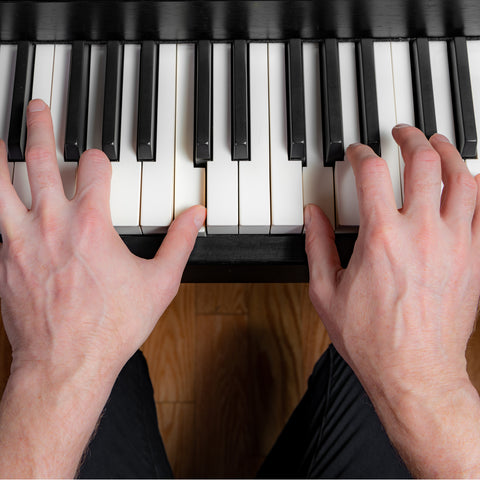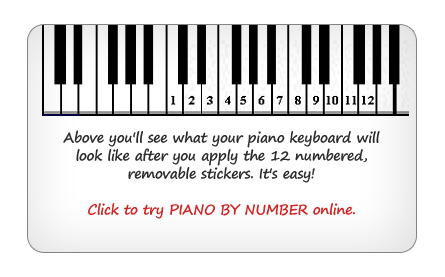Piano Key Numbers

Piano key numbers can refer to different things. One use of the term is the practice of numbering the keys of the piano on the invisible side of the key. This is to make re-assembly easier and prevent confusion for repair people. These numbers (and letters) are found on the side of the piano key. They are invisible to the user unless the piano is dis-assembled.
The problem with the lettering method of keytop identification is that different manufacturers use different lettering systems to identify the keys. For this reason, it has become standard to simply number the keys starting with 1 on the bottom key, including the black keys. The total on any standard size piano is 88: there are 88 keys.
Number The Keys For Kids
But "numbering" can also refer to numbering the top surface of the piano keys. This is what we do in Piano By Number. See the drawing below. If you're familiar with "Solfege," the number one (1) represents "do."
Putting a visual reference on the key surface makes it easier for kids to find the notes of the song they wish to play. Many methods use different devices, such as letters, colors or animals. But there are drawbacks to each of these methods. Letters are harder for kids to use because, while the ascending alphabet is easy to understand, A B C D, the descending version, D C B A, is much harder for kids to understand quickly.
Colors are irrelevant to future study of the piano, although they can be an easy way to get very young kids playing. Animals are equally irrelevant to music study. You may say that the “lion” represents Middle C, but another product may say that Middle C is a “chicken.”
Piano Is Easy
Why Numbers Work For Kids
We chose numbers for several reasons. First, numbers are instinctive to kids. They can count up or down with equal ease. Thus they can make music immediately. Try playing on our online piano below.
Using Numbers On The Key Surface
It's easy for kids to see the direction of the music (up/down) using numbered stickers:
UP
1 2 3 4 5 6 7 8
8 7 6 5 4 3 2 1
Numbers Are Relevant To Music Study
The basis of all musical construction is mathematical. For example, chords are referred to by means of Roman Numerals (1 = I, 2 = II.) The distance between any two keys is called an "interval" and is expressed as a number. Thus, the distance between C and G (1 and 5 in Piano By Number) is called a "fifth." There are countless other examples of the relevance of numbers to music.
Give Kids A Musical Language They Can Understand
Reading music is very difficult for kids. We use numbers to get kids started playing interesting, familiar music from the first day. This prevents frustration and confusion. Conventional methods all start with unfamiliar, boring exercise pieces designed to begin the difficult process of understanding sheet music. Once kids have discovered how fun the piano can be, we begin the lengthy process of learning to read music.
BOOKS FOR YOUNGER KIDS
REFERENCES
Introductory
Playing Piano By Number
Playing Piano By Number – Complete
Starting To Play Piano By Number
Beginning Piano Music With Numbers
Beginner Piano Tutorial
Beginner Piano Books for Kids
Introduction To Piano By Number
Music On The Mind: Newsweek Articles
Piano By Number Basics
Piano By Number Is The Missing Step
There Are Many Ways To Start Piano
A History of Piano and Numbers
Basic Piano Skills for Kids
Easy Piano Songs for Beginners with Letters
Easy Piano Notes for Popular Songs







Please i need Piano keyboard numbering / nomenclature e.g C1,D1,E1,F1,G1,A……. Both on full size Piano and others